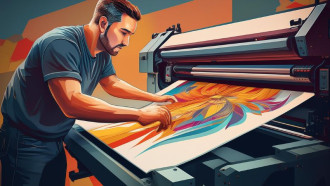In the digital age, where technology permeates every aspect of our lives, art and interior decoration are no exceptions. Canvas prints are a fascinating fusion of traditional painting aesthetics with modern digital printing capabilities. This innovative technique has revolutionized the way we create, reproduce, and display visual art.
In this article, we delve into the world of canvas prints, uncovering the secrets of the technology behind their production, analyzing the numerous advantages of this method, exploring its various applications, and examining the materials used in the creation process. Whether you are an artist, art collector, interior decorator, or simply a lover of beauty, this guide will provide you with valuable insights into this versatile and popular form of art.
Join us on a captivating journey through the world of canvas prints, where tradition meets innovation, and technology opens new horizons for creativity and artistic expression.
What is canvas printing and how does it work?
Canvas printing is a technique of transferring images, photos, or graphics onto canvas, a material with a characteristic texture often used in traditional painting. Unlike paper printing, canvas printing offers a more artistic and three-dimensional effect, making the images look like hand-painted works of art.
Basic elements of the process
The canvas printing process starts with preparing a digital image. This image is then printed on canvas using special printers that utilize pigment or solvent inks. After printing, the canvas is often stretched over a wooden frame, giving it the proper form and stability. In some cases, the image may be additionally protected with a varnish to enhance its durability and resistance to external factors.
Differences between canvas printing and other techniques
Canvas printing differs from other printing techniques, such as printing on photographic paper, PVC, or aluminum, in several key aspects:
- Texture: The canvas has a unique texture that adds depth and character to the image.
- Durability: Canvas prints are more resistant to fading and mechanical damage.
- Aesthetics: Canvas prints have a more artistic appearance, reminiscent of traditional painting.
How has canvas printing technology developed over the years?
The first attempts at canvas printing date back to the late 19th century when artists and printers began experimenting with transferring images onto materials other than paper. At that time, the technology was still in its infancy, and the results often did not meet expectations in terms of quality and durability.

The real breakthrough came in the 1980s with the development of digital printing technology. The introduction of inkjet printers capable of printing on canvas opened new possibilities for artists and photographers. The high quality of the prints and the ability to accurately reproduce colors made canvas printing popular.
Evolution of printing technology
Earlier methods of canvas printing, such as screen printing or lithography, were time-consuming and required a lot of labor. Digital printing revolutionized this process, allowing for quick and precise image transfer onto canvas. This made canvas printing accessible to a wider audience, significantly reducing production costs.
Key technological innovations
The introduction of pigment inks, which are more resistant to fading, and the development of UV printing technology, which allows direct printing on various surfaces, were key innovations in canvas printing. These technologies ensure high quality and durability of prints, which is especially important for art and photography reproductions.
Popularization of canvas printing
Canvas printing quickly gained popularity among artists and photographers who appreciated its aesthetic qualities and durability. Art reproductions printed on canvas look almost identical to the originals, making them popular in galleries and museums. Photographers, on the other hand, value the ability to present their works in the form of large, impressive prints.
Impact on the interior decoration market
Canvas printing also became popular among those looking for unique decorations for their homes and offices. Canvas prints are elegant and durable, while also being available in a wide price range, making them an attractive option for a broad audience. The possibility of personalization allows everyone to create a unique canvas print that perfectly fits their interior decor.
What are the main advantages of canvas printing?
Canvas printing has gained immense popularity in recent years, thanks to numerous advantages offered by this technique. Firstly, canvas prints are characterized by exceptional aesthetics and appearance. The texture of the canvas gives the images depth and character, which cannot be achieved on smooth photographic paper. This unique texture makes canvas prints resemble traditional oil or acrylic paintings, adding artistic charm and prestige. This effect is particularly valued in art reproductions, where fidelity to the original is crucial.

Another significant advantage is the durability and resistance of canvas prints. By using high-quality pigment inks and proper post-print processing, canvas prints are resistant to fading and can retain vivid colors for many years, even when exposed to light. Additionally, the canvas is a material more resistant to mechanical damage than paper, making the prints less prone to creases or tears.
Versatility of applications is another benefit of canvas printing. This technique works excellently in various contexts – from decorating private homes to arranging office spaces and art exhibitions. The ability to print in various sizes, from small formats to large-scale images, allows for adapting the prints to different spaces and needs.
It is also worth mentioning the ecological aspect of canvas printing. Compared to traditional methods of producing images, digital canvas printing generates less waste and uses fewer resources. Additionally, many companies offering this service use eco-friendly inks and canvases, making this technique more environmentally friendly.
The economic aspect is also significant. Canvas printing allows for creating high-quality reproductions of artworks or photographs at affordable prices, making art more accessible to a wider audience. For artists and photographers, this means the possibility of selling their works in the form of limited edition canvas prints, which can be an important source of income.
Finally, the flexibility and ease of transport are other advantages of canvas prints. Unlike traditional oil paintings, canvas prints can be easily removed from the frame and rolled up, making storage and transport easier. This is particularly valuable for art collectors, galleries, or people who frequently change their place of residence.
In summary, canvas printing offers a unique combination of aesthetics, durability, versatility, and practicality. These advantages make it a preferred technique among professional artists and photographers, as well as those looking for original decorations for their interiors. With the development of printing technology, we can expect further improvements in this technique, bringing even more benefits in the future.
In which fields is canvas printing used?
Thanks to its versatility and aesthetic qualities, canvas printing is used in many different fields, significantly influencing the way we present and experience visual art.
Art and reproductions
In the art world, canvas printing has revolutionized the way we can enjoy the works of great masters. Museums and galleries use this technique to create high-quality reproductions of valuable paintings on canvas, allowing a wider audience to admire masterpieces that would otherwise be inaccessible. These reproductions are often used for educational purposes, allowing art students to closely study the techniques and styles of various artists. Additionally, contemporary artists increasingly use canvas printing as a medium for creating original works, combining traditional painting techniques with modern digital technologies.
Photography
For photographers, canvas printing has opened new possibilities for presenting their works. The texture of the canvas gives photos depth and character, which is difficult to achieve on traditional photographic paper. This is particularly effective in landscape, portrait, and artistic photography. Many professional photographers now offer their works in the form of limited edition canvas prints, enhancing their collectible value. Additionally, canvas printing has become popular among amateur photographers who want to present their best photos in an original way in homes or offices.
Interior decoration
In the field of interior decoration, canvas printing has become an extremely popular choice for both professional designers and individuals furnishing their private spaces. Canvas prints blend well with various interior styles, from classic to modern. The ability to personalize the prints, both in terms of size and content, allows for perfectly matching the decoration to individual needs and tastes. Multi-panel prints (known as multi-canvas) are also becoming increasingly popular, allowing for creating impressive compositions on large wall surfaces.
Advertising and marketing
The advertising and marketing industry has also recognized the potential of canvas printing. Companies use this technique to create impressive displays at trade shows and exhibitions, where the durability and aesthetics of the canvas are perfect for intensive use. Canvas printing is also often used in the arrangement of commercial spaces, such as hotels, restaurants, and offices, where high-quality images help build the right atmosphere and brand image. Additionally, personalized canvas prints are becoming an increasingly popular element of marketing campaigns, serving as exclusive gifts for clients or business partners.
Education and science
In the educational and scientific sector, canvas printing is used to create durable and visually appealing teaching aids. Maps, diagrams, scientific illustrations, or historical reproductions printed on canvas are used in schools, universities, and research institutions. Their durability and resistance to damage make them an ideal choice for frequent use in classrooms or laboratories.
Events and temporary exhibitions
Canvas printing is also often used in organizing events and temporary exhibitions. The ease of transport and assembly of canvas prints makes them an ideal solution for mobile exhibitions. Pop-up galleries, photographic exhibitions, and artistic installations often use this technique to quickly and effectively arrange exhibition space.
In summary, the versatility of canvas printing makes it applicable in a wide range of fields – from high art, photography, and interior decoration to advertising, education, and event organization. This technique has not only democratized access to art but also opened new possibilities for creative expression and the presentation of visual content in various contexts. As printing technology continues to develop, we can expect even broader applications of this technique in the future.
What materials are used in canvas printing and how do they affect quality?
The choice of appropriate materials in the canvas printing process is crucial for the quality of the final product. Both the type of canvas and the inks or paints used significantly affect the durability, appearance, and overall aesthetics of the print.
Types of canvas
The canvas serves as the base for printing and is available in several varieties, each with its unique properties:
1. Cotton canvas
This is the traditional and most valued type of canvas. It has a natural texture and warm tone, giving prints an authentic, artistic look. Cotton absorbs inks well, providing deep, saturated colors. However, it is more susceptible to stretching and may yellow slightly over time, which should be considered for long-term storage.
2. Polyester canvas
This is a synthetic alternative that is gaining popularity due to its durability and resistance to stretching. Polyester canvas maintains dimensional stability even in varying humidity and temperature conditions. It has a smoother surface than cotton, which can be beneficial for high-resolution photographic prints.
3. Cotton-polyester blends
These canvases combine the advantages of both materials. Typical proportions are 65% polyester and 35% cotton, providing a good balance between the natural look of cotton and the durability of polyester. These blends are often chosen as a versatile solution, suitable for both art reproductions and photography.
The choice of canvas type depends on the intended use of the print, the desired visual effect, and the conditions in which the image will be displayed.
Paints and inks
The quality of paints and inks has a huge impact on the durability and appearance of canvas prints. There are two main types:
1. Pigment inks
These are currently the most commonly used inks in high-quality canvas printing. They contain fine pigment particles suspended in a liquid, which, after drying, form a durable layer on the canvas surface. Pigment inks are characterized by:
- Excellent fade resistance (up to 100 years under proper conditions)
- High resistance to moisture and UV radiation
- Deep, saturated colors
- Good adhesion to various types of canvas
2. Dye-based inks
Although less commonly used in professional canvas printing, dye-based inks still have their applications. They are characterized by:
- A wider color gamut than pigment inks
- Greater brightness and color saturation
- Lower fade resistance (usually up to 25-30 years)
- Lower resistance to moisture and UV radiation
The choice between pigment and dye-based inks depends on the intended use of the print and the expected durability. For high-quality artistic and photographic prints that are meant to last a long time, pigment inks are definitely preferred.
Impact of materials on the quality of the final product
The combination of chosen canvas and ink directly affects several characteristics of the final print:
1. Color durability: High-quality canvas combined with pigment inks ensures the best resistance to fading.
2. Depth and color saturation: Cotton canvas typically provides deeper, more saturated colors due to its texture and ink absorption ability.
3. Sharpness and detail: Smoother polyester canvases can provide better detail sharpness, which is important especially in photography.
4. Texture and artistic effect: Natural cotton canvas gives a more authentic, painterly effect, while synthetic canvases can provide a more uniform appearance.
5. Resistance to external factors: The combination of appropriate canvas (e.g., cotton-polyester blend) with pigment inks ensures the best resistance to moisture, UV radiation, and temperature changes.
6. Physical durability: Polyester and mixed canvases are more resistant to stretching and deformation, which is important for large formats and long-term exposure.
In summary, the choice of materials for canvas printing should be dictated by the intended use, expected durability, and desired visual effect. Professional print shops often offer various combinations of canvases and inks, allowing clients to choose the optimal solution for their specific needs. Regardless of the choice, using high-quality materials is key to ensuring the best possible results and long-lasting satisfaction with canvas prints.
Summary: What is the significance of canvas printing in the modern world?
Canvas printing, though it may seem like just one of many reproduction techniques, actually plays a significant role in the modern world of art, design, and visual communication. Summarizing our considerations, it is worth looking at the key points that highlight its importance and impact on various aspects of our lives.
Key points
- Democratization of art. Canvas printing has revolutionized access to art. High-quality reproductions of masterpieces, once available only in renowned galleries and museums, can now adorn the walls of homes, offices, and institutions worldwide. This democratization of art allows a wider audience to engage with the works of great masters, contributing to the artistic awareness of society.
- New opportunities for artists. For contemporary artists, canvas printing has opened new paths for expression and distribution of their works. The ability to create limited editions of high-quality prints allows artists to reach a broader audience while maintaining control over the quantity and quality of reproductions. This, in turn, translates into new business models in the art world.
- Revolution in interior decoration. Canvas printing has significantly influenced the way we decorate our living and work spaces. The ability to personalize and customize images to specific interiors allows for creating unique, personalized spaces that reflect individual tastes and lifestyles.
- Technological innovations. The development of canvas printing technology stimulates innovations in the field of printers, inks, and materials. These technological advancements have broader applications, extending beyond artistic printing, influencing the development of other printing and textile industries.
- Impact on education and science. In the educational and scientific sector, canvas printing enables the creation of durable and visually appealing teaching aids. From historical maps to complex scientific diagrams, this technique supports the teaching and research process, making it more engaging and effective.
- Sustainable development. Compared to traditional methods of producing images, canvas printing often proves to be more environmentally friendly. The use of eco-friendly materials and the ability to print on demand contribute to waste reduction and a more sustainable approach to artistic production.
The significance of canvas printing in today's world
Canvas printing goes far beyond its original function of image reproduction. In today's world, it serves as a bridge connecting traditional art forms with modern technologies, creating a new quality in the presentation of visual content.
- Cultural: Canvas printing contributes to the preservation and dissemination of cultural heritage. It allows a broad audience to engage with artworks that might otherwise be inaccessible, supporting artistic and cultural education.
- Economic: It creates new business opportunities for artists, photographers, and designers, enabling them to reach a wider audience. At the same time, it drives the growth of the printing and decorating industries.
- Technological: The continuous pursuit of improved canvas printing quality stimulates innovations in printing technology, which translates to other industry sectors.
- Social: The personalization and availability of high-quality canvas prints allow people to express their individuality through art, contributing to the building of identity and aesthetic appreciation.
- Ecological: The development of eco-friendly canvas printing methods aligns with global trends of sustainable development and responsible consumption.
In conclusion, canvas printing, though it may seem like just a reproduction technique, is actually a catalyst for change in many areas - from art and design to education, science, business, and ecology. Its significance in the modern world extends far beyond the boundaries of traditional printing, making it an essential element in shaping our visual culture and the way we experience art in everyday life. As technology continues to evolve, we can expect canvas printing to keep evolving, opening new possibilities and influencing our perception and interaction with art and images.

Kinga
product manager at Wallyboards
Kinga is the heart of our team – she’s the one you’ll most often speak to when you write or call Wallyboards. With passion, she helps customers choose the perfect products for their home or office, sharing her knowledge about features and practical uses. Her experience and dedication mean even the most technical questions get quick and accurate answers.







